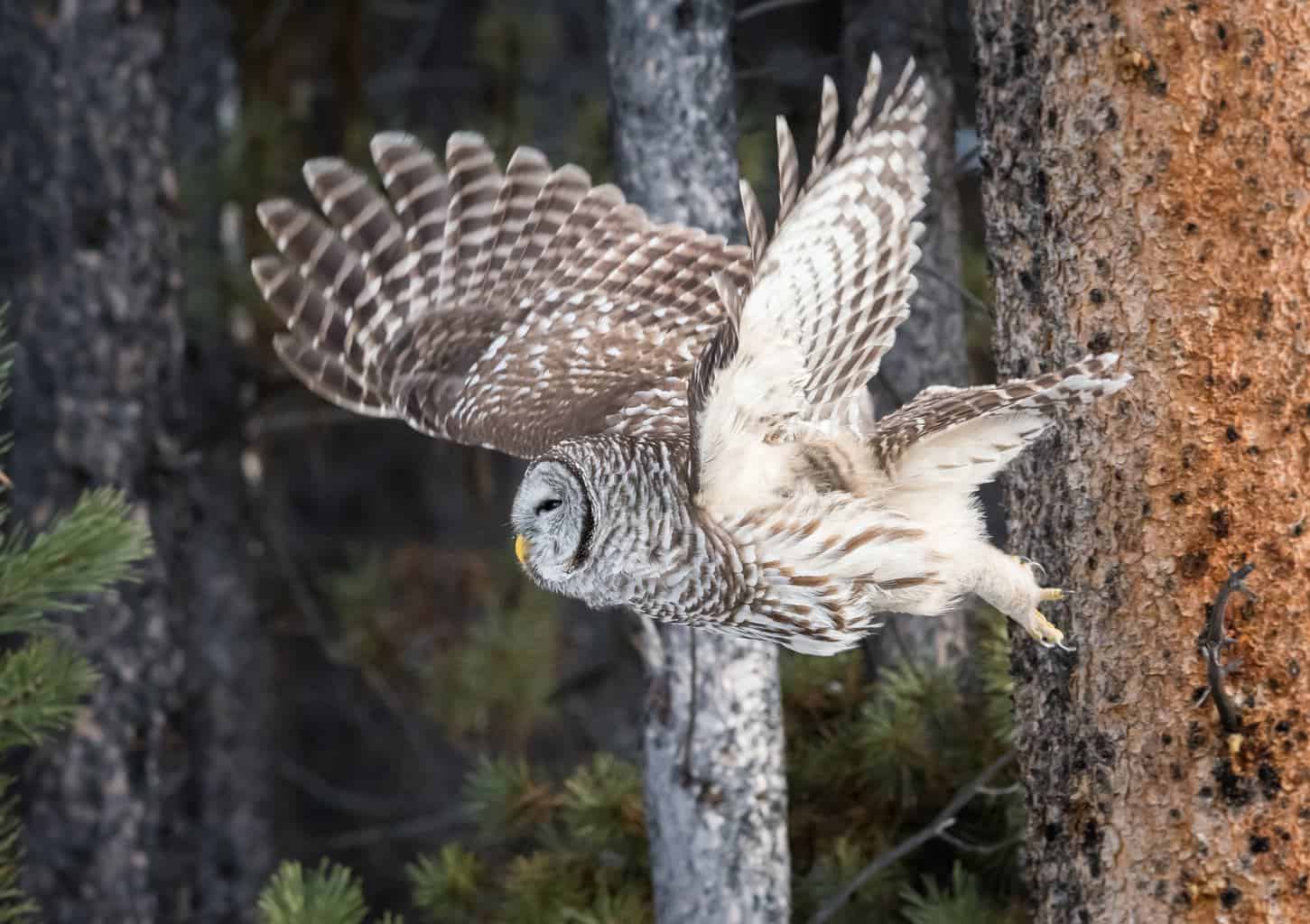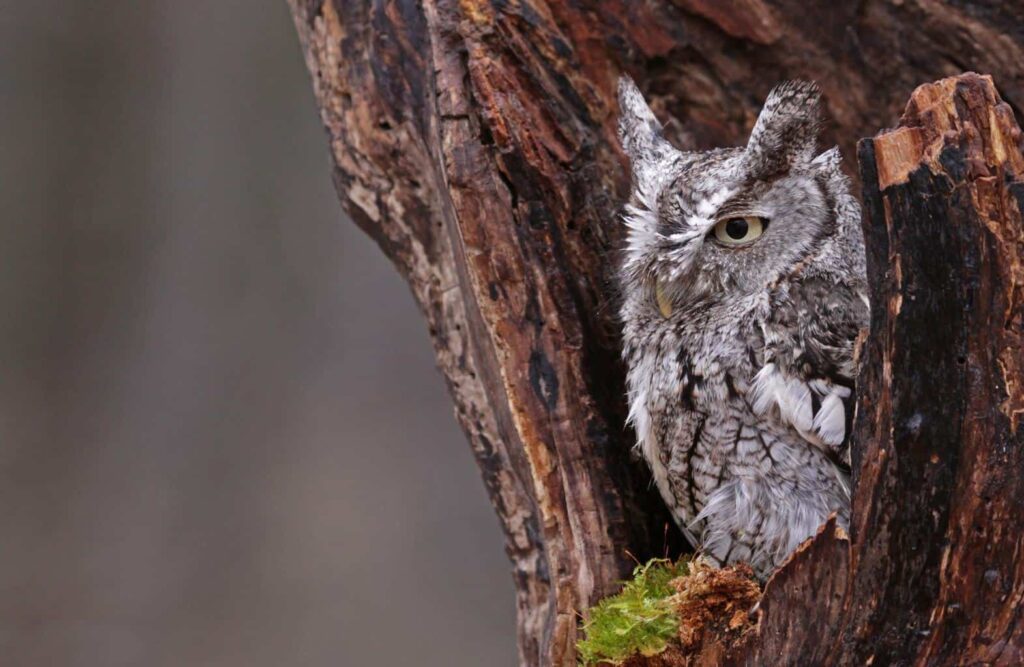Iowa is home to an impressive array of bird species, including owls! The state is home to nine different species of them, from the common and widespread great horned owl to the more rarely seen burrowing owl.
While some of these majestic birds only make the state a quick stop on their migratory treks, other owls live in Iowa year-round; luckily for you, our avid birdwatching friend, our list covers all of them. Read on to learn more!
Great Horned Owl

- Scientific Name: Bubo virginianus
- Length: 18.1-26 inches
- Weight: 50 ounces
- Wingspan: 55.2 inches
The great horned owl is the most well-known species of these birds in Iowa, sporting a thick body and prominent feather tufts on top of its head.
It’s hard to find a bird more adaptable to its environment than the great horned owl. Its habitat is pretty much limitless, so long as there are rocky nesting sites and trees available. The owl can live in rainforests, desert fringes, tundra, swamps, prairies, and even urban areas.
These owls can hunt and prey on any other species of Iowa owls. They can also eat mammals bigger than they are, and sometimes, they’ll even try to prey on little pets, like lap dogs!
In Iowa, great horned owls start to settle into their nests as early as January. They prefer nesting in pine trees and cottonwood, and sometimes they’ll use vacant or unoccupied nests that were built by other species of birds. They may also use manmade structures or tree cavities.
Juvenile great horned owls are extremely fluffy, and like the adults of the species, they have yellow eyes and downy white heads that are outlined by a darker facial disk. Their feathers are different, however, depending on where they live.
Great horned owls have brown-grey feathers on their bodies and rosy red faces. They also have a patch of white feathers on their throats. Great horned birds in Iowa, however, have an orangey or yellowish-brown colored facial disk.
Northern Saw-Whet Owl

- Scientific Name: Aegolius acadicus
- Length: 6.5-9 inches
- Weight: 1.9-5.3 ounces
- Wingspan: 16.5-22.2 inches
The northern saw-whet owl is the smallest species of these birds in Iowa. These tiny adorable owls are found throughout the state during the colder times of the year.
Most owls swallow their prey whole, but the northern saw-whet owl cuts its food into smaller pieces and keeps the other parts for later. During the winter months, the food saw-whets set aside for later meals usually freeze. When the birds start getting hungry, they lay on the food to defrost and thaw it.
If you want to catch a glimpse of a northern saw-whet owl, tune in to hear their sharp, rhythmic “tooo-tooo-tooo” call on calm evenings in woodlands and forests.
Eastern Screech-Owl

- Scientific Name: Megascops asio
- Length: 6-10 inches
- Weight: 5.6 ounces
- Wingspan: 19-24 inches
Eastern screech-owls are the second smallest owl species taking up permanent residence in Iowa. Since the birds are just about the size of a pint glass, they may be a bit challenging to spot.
While sleeping during the day, the screech-owl covers itself with bushes and small wood, making its quills and feathers its camouflage among the dense forest.
Eastern screech-owls’ feathers are generally a reddish-brown, earthy, or grey color with complex patterns that mesh well with tree bark and foliage. Their ear tufts are always raised, which gives them a distinct silhouette that’s similar to that of a great horned owl.
Despite the implications of the bird’s name, the eastern screech-owl rarely screeches. Typically, they only do so when they’re defending their nests or fledglings. Instead, their calls primarily consist of low and soft whinnies, quavers, or hoots.
Eastern screech-owls prey on insects and small animals, like frogs, small birds, and even bats. When food sources are scarce, the owls can be cannibalistic, even going as far as eating their siblings or the smallest fledgling in the nest.
Barn Owl

- Scientific Name: Tyto alba
- Length: 12.6-15.8 inches
- Weight: 14.1-24.7 ounces
- Wingspan: 39.4-49.2 inches
Though not yet federally endangered, barn owls’ population is low in Iowa. That’s because they’ve suffered a decline in prey and habitat loss due to grassland and agricultural changes.
Barn owls were also affected by DDT use in the twentieth century. DDT is used for rodent poison, and rodents are the primary food source for these owls. Great horned owls are a significant threat to barn owls’ existence, as they prey on this species among other Iowan owls.
What’s intriguing about these owls is that they swallow their prey whole, then they cough out the remaining pellets instead of passing them all down into their digestive tract system. The remains they cough up help researchers know more about what this species eats and how they live in certain environments.
Barn owls have dark eyes and pale feathers covering their bodies. Their upper wings, heads, and backs are a yellowish-beige and gray color, and their bodies, underwings, and faces are normally white.
Long-Eared Owl

- Scientific Name: Asio otus
- Length: 13.7-15.7 inches
- Weight: 8.81 ounces
- Wingspan: 35.4-40 inches
The long-eared owl is known as the cat owl because of its feline-like facial features. Its name, long-eared, comes from the long tufts of feathers on their heads.
Long-eared owls migrate south and spend their breeding season in the north, and while these owls are found in Iowa during the fall and winter months, they’ll leave the state during springtime.
They often roost in large groups during the wintertime and can often be found roosting in grooves of trees or pine stands as well as grasslands. Rather than making their own homes, long-eared owls will steal another bird’s nest to occupy.
These secretive birds stay superbly camouflaged, so one way you can find them is by listening for their long, low hoots. Males have extremely loud sounds, including hoots, barks, and squeals, that can sometimes be heard from up to one kilometer away.
Short-Eared Owl

- Scientific Name: Asio flammeus
- Length: 13-17 inches
- Weight: 7.3-16.8 ounces
- Wingspan: 33-43 inches
Short-eared owls are known to be one of the most commonly distributed owl species in the world, and you can find these Iowa residents throughout the state all year long. They’re most frequently spotted during the day, flying low over grasslands and staying in open spaces.
Unlike other owls, this species is diurnal, which means it’s active during the day. Its diet primarily consists of voles and mice, and it also enjoys taking down smaller bird species and bats.
Before they eat, the short-eared owl eviscerates and decapitates their prey before swallowing them whole. Usually, when they catch birds, they’ll take their wings off before feeding on them.
These owls have tremendously short ear tufts that often appear invisible. But you can easily identify the bird by its conspicuous black-rimmed yellow eyes and pale facial disk.
Barred Owl

- Scientific Name: Strix varia
- Length: 16-25 inches
- Weight: 26 ounces
- Wingspan: 38-49 inches
Barred owls can be found in most places throughout Iowa, however, they’re largely unavailable in the northwest portion of the state. These owls are homebodies, too, which means they’re not migratory.
A study of 158 owls found that none had moved farther than 6 miles from where they were originally born. So, you’ll find barred owls in the state throughout the whole year. They prefer staying near bodies of water, like rivers and streams in wooded areas.
Barred owls can be recognized by their distinctive calls, which sound like the bird’s asking, “Who cooks for you?” You may also be lucky enough to spot one perching in a tree. Barred owls are known to make appearances in city streets and urban areas more often than in other spaces.
Snowy Owl

- Scientific Name: Bubo scandiacus
- Length: 25-28.7 inches
- Weight: 70.5 ounces
- Wingspan: 48-60 inches
Snowy owls aren’t frequent winter visitors in Iowa. They may show up in certain winters and not in others, which means that any time a snowy owl is spotted in Iowa, it’s a pretty big deal.
The reason snowy owls are so heavy is because of their extremely thick feathers that protect them from the Arctic cold. They even have thick leg feathers that make them look very squatty when they’re sitting.
In Iowa, it’s easy to spot snowy owls as they sit close to the ground searching for prey. They’ll also remain in the same spot for quite a while as they look and listen for prey. Their essential food source is lemmings and rodents.
It’s common to think that snowy owls have fully white bodies, but they don’t. Males of this species have brown stripes when they’re young and turn white as they get older. Females, on the other hand, have dark markings throughout their lives. The whitest birds are always males, and the darker snowy owls are often females.
Burrowing Owl

- Scientific Name: Athene cunicularia
- Length: 7.5-9.8 inches
- Weight: 5.3 ounces
- Wingspan: 21.6 inches
Burrowing owls can be found in the northwestern part of the state during their breeding season, which starts in late March or April and keeps going throughout the summertime.
We expect to see owls on trees, however, burrowing owls live in underground holes they create. They also take over pre-dug holes from ground tortoises or squirrels. In Iowa, they use badger holes, too, and prefer to reside in open environments where they can chase rodents and insects.
Sometimes, the burrowing owl puts creature waste or manure at the opening of its tunnel to attract bugs. Then, these bugs find themselves in the owl’s mouth!
Final Thoughts
Iowa has two national parks and 83 state park areas, giving birds plenty of spaces to be spotted in. When winter settles solidly into Iowa, owls start appearing more and more; they can even be seen from the comfort of your own home!

